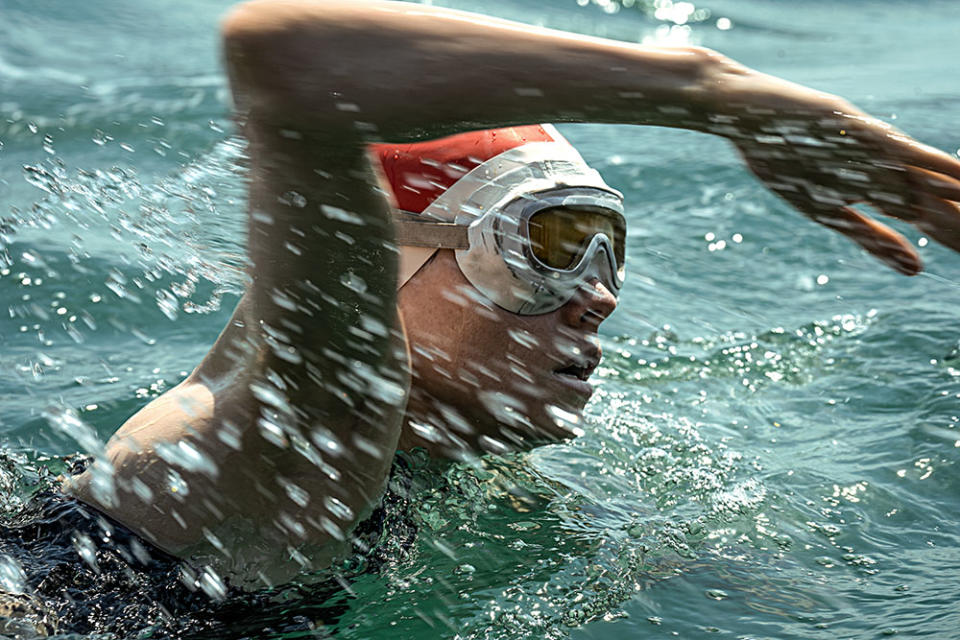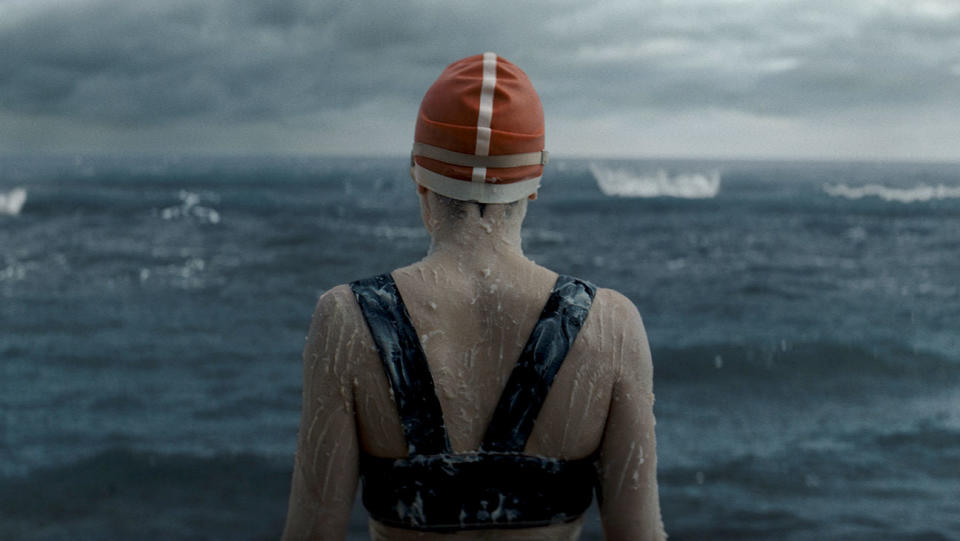‘Young Woman and the Sea’ Director Joachim Rønning on the Film’s Theatrical Upgrade: “Jerry Bruckheimer Is Relentless”

Young Woman and the Sea allowed Norwegian director Joachim Rønning to return to his roots in more ways than one.
As he was helming Pirates of the Caribbean: Dead Men Tell No Tales (2017) and Maleficent: Mistress of Evil (2019) for Disney, Rønning was in development on a biopic about Olympic swimmer Gertrude “Trudy” Ederle, who became the first woman to swim across the English Channel in 1926. What would normally seem like a big left turn for a filmmaker who’d been steeped in fantasy worlds was actually a return to the genre of historical drama that first launched his Hollywood career.
More from The Hollywood Reporter
In 2013, Rønning and co-director Espen Sanderg’s Norwegian film, Kon-Tiki, received an Oscar nomination for best foreign language film at the 85th Academy Awards. The picture chronicled Thor Heyerdahl’s 1947 expedition from South America to the islands of Polynesia, as both Kon-Tiki and Young Woman and the Sea are partially about pulling off what was once thought to be impossible. They also took on the notoriously difficult challenge of shooting practically on the ocean, something Rønning was familiar with having grown up near the sea in Norway.
Once Young Woman was eventually completed and screened, the audience test scores went through the roof, setting a personal record for producer Jerry Bruckheimer, who has no shortage of crowd-pleasing hits such as Top Gun and Top Gun: Maverick. However, Young Woman was originally intended to be an exclusive release for Disney+, so Bruckheimer went to work, refusing to let Rønning’s film go without some form of a theatrical release. Fortunately, it now boasts a limited theatrical release in connection with the upcoming Summer Olympics in Paris, which is the same location where Ederle won gold a century ago.
“We held it against [Disney], and Jerry Bruckheimer is relentless. He really went for it,” Rønning tells The Hollywood Reporter. “So it wasn’t that it was that hard, but there’s always algorithms and budgets and things like that. So I definitely respect the process, but then we got [a limited theatrical release]. So I’m just thrilled to be able to show an epic story like this on the big screen.”
Between his history with Disney and Young Woman’s test scores, Rønning was rewarded with Tron: Ares, the follow-up to 2010’s Tron: Legacy, which was helmed by another one of Bruckheimer’s most trusted collaborators, Joseph Kosinski. Tron 3 was just two weeks away from cameras rolling when the industry-wide labor stoppages derailed its production, but Rønning remained optimstic that the film would get made for one simple reason.
“A lot of money had already been spent, so we were all pretty confident that we were getting back together, although I never take anything for granted in Hollywood,” Rønning says. “So there’s always a risk, but we got more time to prepare, and that’s never a bad thing.”
Below, during a recent conversation with THR, Rønning also discusses some of the many downsides of shooting on water, such as his star Daisy Ridley being swept away by the Black Sea current on occasion.
You’re most known in America for Pirates of the Caribbean: Dead Men Tell No Tales and Maleficent: Mistress of Evil, but your 2012 historical drama, Kon-Tiki, likely opened the door to those two Disney films. Do you consider Young Woman and the Sea to be your way of picking up where you left off with Kon-Tiki?
Well, like Kon-Tiki, Young Woman and the Sea is a much more personal film for me, even though it’s about a young woman. It’s obviously a tribute to Trudy Ederle and what she accomplished back in the day, but it’s also an inspiring story that I wanted to tell, much like Kon-Tiki. Kon-Tiki was about how I saw myself in the main role of someone chasing their dream at any cost, and the price of that, very often, is paid by the people around them. So Young Woman is a story similar to that, but it’s a story that I can tell to my teenage daughters and the daughters of the world, and I felt a great responsibility to get it right.

Well, you certainly got it right, as it’s the highest testing film of Jerry Bruckheimer’s career. That’s an incredible bragging right to have, so what’s the story behind when those numbers first came in?
It’s just wonderful when you get that [score], because you never know how these things will go, especially a movie like this. We spent almost ten years trying to get it made, and any movie or enterprise that involves a lot of people and equipment is always going to be challenging. But I really wanted to film on the water and on the ocean. I did that with Kon-Tiki, and I felt it was such a great way to tell this story. It’s important to be as truthful and real as possible to Trudy’s journey and crossing. So it was a challenging project from A to Z, and when we showed it to an audience and they responded in such a great way, it was just a huge reward at the end of the road.
And how soon did everyone broach the subject of adding a theatrical component to what was supposed to be a Disney+ exclusive?
It was pretty immediate after that. We held it against [Disney], and Jerry Bruckheimer is relentless. (Laughs.) He really went for it. So it wasn’t that it was that hard, but there’s always algorithms and budgets and things like that. So I definitely respect the process, but then we got [a limited theatrical release]. And not to sound pretentious or anything like that, but I feel that my art form is cinema. That’s what I grew up with, and that’s what inspired me to become a filmmaker. So I’m just thrilled to be able to show an epic story like this on the big screen.
Several directors have shared similar stories where they asked Steven Spielberg for advice about shooting on water, and apparently, he always says to avoid it at all costs. Having worked on water quite a bit, do you understand full well why he says that?
(Laughs.) Yeah. I grew up by the water, and while I’m drawn to stories about it, it is complex. Making any movie is complex, but you add complexity to it when you are on water with dozens of boats and camera boats and cranes and safety boats and picture boats. And all of it is moving with the current, and once you put your actor in the water, she’s suddenly 200 yards away because she was swept away [by the current]. So you get all of that, but the reward is so great when you’re later sitting in your warm editing room and you see those things. You’re taken on a real adventure. I told the crew and everybody else that I wanted this to be old-school filmmaking. I didn’t want to shoot in the tank. I didn’t want to shoot with blue screen. We get enough of that in other types of films, and while I have nothing against that, it was so important to try to get as close as possible to Trudy’s story. So I hope the audience feels that somehow.

As mentioned, you’ve worked with Disney a couple of times already, but Hollywood is such a what-have-you-done-for-me-lately kind of town. So did your performance on Young Woman and the Sea ultimately land you Tron: Ares?
I think so. As you say, every movie is hopefully a stepping stone, and I just feel so fortunate to be able to work on so many different stories and make different kinds of movies. I wrapped Tron just a week ago, and it’s so liberating to be out of the Tron grid, so to speak, and out on the ocean with Trudy. I feel lucky to be able to do this. And now I’m going back into the dark editing room for a year on Tron, but I really am grateful. Nothing comes automatically. These things take a lot of hard work from a lot of people, and they need to be consistently great. So I’m very humbled by that.
Tron: Ares‘ production was delayed due to the strikes, and there was so much uncertainty about how things would unfold from there. Did you always remain pretty confident that you’d get to go back and make it?
Yes, I did. I felt really bad that it took this long to find a solution, but it was definitely a good thing that the strikes resolved in a good way for the unions and for myself. I felt bad for the crew in America and in Toronto, Canada where we were filming, but we were so far along already. We were only a couple of weeks out from principal photography when we had to shut down, which made it extra hard, because you had to lay off hundreds of people who were already working. But a lot of money had already been spent, so we were all pretty confident that we were getting back together, although I never take anything for granted in Hollywood. So there’s always a risk, but we got more time to prepare, and that’s never a bad thing.
***
Young Woman and the Sea is now playing in movie theaters.
Best of The Hollywood Reporter

 Yahoo News
Yahoo News 
